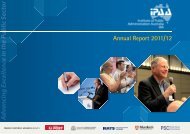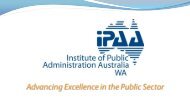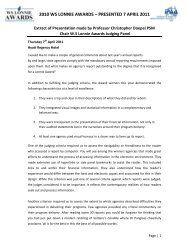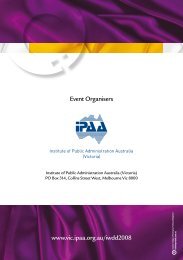Review of Victoria's integrity and anti-corruption system - IPAA Victoria
Review of Victoria's integrity and anti-corruption system - IPAA Victoria
Review of Victoria's integrity and anti-corruption system - IPAA Victoria
- No tags were found...
You also want an ePaper? Increase the reach of your titles
YUMPU automatically turns print PDFs into web optimized ePapers that Google loves.
2.1.2 misconductMisconduct is more serious than maladministration. There is an additional level <strong>of</strong> recklessness orintent beyond maladministration – misconduct is more than not paying attention or exercising duediligence. It can involve breaches <strong>of</strong> codes <strong>of</strong> conduct <strong>and</strong> there may be an element <strong>of</strong> dishonestyinvolved. Sanctions can include demotion, removal <strong>of</strong> privileges or removal <strong>of</strong> the person from theposition. In <strong>Victoria</strong>, misconduct in public <strong>of</strong>fice is a common law <strong>of</strong>fence. Details about theelements <strong>of</strong> this <strong>of</strong>fence <strong>and</strong> other definitions <strong>of</strong> misconduct in <strong>Victoria</strong>n statutes can be found inAppendix E.2.1.3 <strong>corruption</strong>Corruption goes beyond misconduct <strong>and</strong> involves different forms <strong>of</strong> the ‘misuse <strong>of</strong> power or themisuse <strong>of</strong> <strong>of</strong>fice’. In its widely used definition, the World Bank also adds the element <strong>of</strong> personalgain, describing <strong>corruption</strong> as ‘the abuse <strong>of</strong> public power for private benefit’. 10 The preciseboundaries <strong>of</strong> <strong>corruption</strong> are difficult to define but the term is usually used to describe seriouswrongdoing such as bribery, embezzlement, fraud <strong>and</strong> extortion. Typically, <strong>corruption</strong> underminespublic trust, has a major impact on an organisation’s reputation <strong>and</strong> has serious implications for anindividual’s future employability or electability. Sanctions for <strong>corruption</strong> generally involve termination<strong>of</strong> employment <strong>and</strong> possible penalties arising from a successful criminal prosecution.2.2 why <strong>integrity</strong> is importantThe public is entitled to expect that public <strong>of</strong>ficials will act with <strong>integrity</strong> <strong>and</strong> that <strong>corruption</strong> ormisconduct is identified <strong>and</strong> addressed. Citizens expect public <strong>of</strong>ficials to uphold values such ashonesty <strong>and</strong> truthfulness <strong>and</strong> to act in the public’s interest in performing their duties. Fair, reliable<strong>and</strong> <strong>system</strong>atic decision-making in public services engenders public trust <strong>and</strong> creates a levelplaying field for interactions with public agencies. Integrity is necessary for government to belegitimate, trusted <strong>and</strong> effective <strong>and</strong> is thus a key element <strong>of</strong> good governance. 11In contrast, maladministration, misconduct <strong>and</strong> <strong>corruption</strong> can be seen as a <strong>system</strong>ic failure inpublic administration <strong>and</strong> an indication <strong>of</strong> poor governance. This lack <strong>of</strong> <strong>integrity</strong> can have asignificant negative impact on public perceptions <strong>and</strong> public trust in decision making by public<strong>of</strong>ficials.2.3 what is an <strong>integrity</strong> <strong>and</strong> <strong>anti</strong>-<strong>corruption</strong><strong>system</strong>?An <strong>integrity</strong> <strong>system</strong> is a series <strong>of</strong> institutions <strong>and</strong> practices that, collectively, aim to build <strong>integrity</strong>,transparency <strong>and</strong> accountability in the public sector. The <strong>system</strong> is a mix <strong>of</strong> institutions, laws,regulations, codes, policies <strong>and</strong> procedures that provide a framework <strong>of</strong> checks <strong>and</strong> balances, t<strong>of</strong>oster an environment <strong>of</strong> high quality decision making, <strong>and</strong> to identify <strong>and</strong> address inappropriatebehaviour including <strong>corruption</strong>. 12The <strong>system</strong>’s role is to promote high st<strong>and</strong>ards <strong>of</strong> <strong>integrity</strong> throughout the public sector as well asto identify, investigate <strong>and</strong> respond to maladministration, misconduct, <strong>and</strong> <strong>corruption</strong>. Keyfunctions <strong>of</strong> <strong>integrity</strong> <strong>and</strong> <strong>anti</strong>-<strong>corruption</strong> <strong>system</strong>s include:10Kaufman, D 1997, Corruption: The facts, World Bank working paper, viewed 2 February 2010, .11OECD 2009, OECD: Integrity framework, viewed 15 March 2010, .12Pope, J 2000, TI Sourcebook 2000. Confronting <strong>corruption</strong>: The elements <strong>of</strong> a national <strong>integrity</strong> <strong>system</strong>, TransparencyInternational, Berlin.4 | <strong>Review</strong> <strong>of</strong> <strong>Victoria</strong>’s <strong>integrity</strong> <strong>and</strong> <strong>anti</strong>-<strong>corruption</strong> <strong>system</strong>









